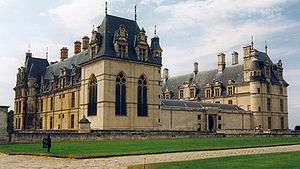Château d'Écouen
| Château d'Écouen | |
|---|---|
 | |
| General information | |
| Type | Château |
| Architectural style | Renaissance |
| Town or city | Écouen |
| Country | France |
| Design and construction | |
| Architect | Jean Bullant |
The Château d'Écouen is a historical château in the city of Écouen, north of Paris, France.
The château was built between 1538 and 1550 by the architect Jean Bullant for Anne de Montmorency, who was made Connétable de France in 1538.
History
Anne de Montmorency had inherited the château in 1515, and his building campaigns were informed by his first-hand experience in overseeing royal works at Saint-Germain-en-Laye and Fontainebleau.[1]
Jean Bullant is likely to have been the architect, for he was commissioned to design the Grand Constable's tomb, but it has also been suggested that Pierre Tâcheron had a hand in the château's design.[2] The colossal order is rare in French architecture before Bullant; his characteristic use of it might be its first appearance in France here, on the pavilion on the court side.[3]
Anne de Montmorency was a major patron of the arts in France, and a protector of artists: his chapel was decorated with sculptures by Jean Goujon, and Jean Bullant, Barthélemy Prieur, Bernard Palissy. Some of the Androuet du Cerceau family found protection and work at Écouen.[4] Unhappily, no building accounts survive, so the precise sequence of the construction cannot be closely followed;[5] panels of grisaille stained glass in the gallery of the west wing are dated 1542 and 1544,[6] and the east wing was paved in 1549-50. The building was frescoed and furnished during the 1550s, in the style of the School of Fontainebleau.
Écouen was illustrated in engravings in Jacques Androuet du Cerceau's Les Plus excellents bastiments de France, 1576.
In 1787 the east (entrance) wing was demolished by the owner, the Louis Joseph de Bourbon, prince de Condé. When he emigrated at the Revolution, Château of Écouen fell to the State, as a "national property" ("bien national").
Museum of the Renaissance
Following an idea of André Malraux the castle was thoroughly renovated by architects of the Monuments Historiques, after having served as a school for daughters of chevaliers of the Légion d'Honneur, from 1807 to 1962,[7] in order to house the "Musée de la Renaissance", comprising the Renaissance objects of the collections of the Musée de Cluny, in sympathetic surroundings. A series of small, highly focussed exhibitions have been staged at Écouen over the years since the museum fully opened in 1982.
Notes
- ↑ See Brigitte Bedos Rezak, Anne De Montmorency: Seigneur de la Renaissance, (Paris:Publisud) 1990, part III.
- ↑ Andrew Ayers, The Architecture of Paris, Fellbach: Edition Axel Menges, 2004, p. 296.
- ↑ Rosalys Coope, "The Château of Montceaux-en-Brie", Journal of the Warburg and Courtauld Institutes 22.1/2 (January - June 1959:71-87) p. 77.
- ↑ Janet S. Byrne, "Monuments on Paper" The Metropolitan Museum of Art BulletinNew Series, 25.1 (Summer 1966, pp. 24-29) p 28.
- ↑ A. Bertrand, Un château à Écouen (1974); John Cornforth, "Château d'Écouen, Seine et Oise" Country Life Magazine 12 July 1984, pp 164-67.
- ↑ Much of the glass from Écouen is now at the Musée Condé, Chantilly. Michael Archer, "'Monmorency's Sword' from Écouen" The Burlington Magazine 129 No. 1010 (May 1987, pp. 298-303) p 301.
- ↑ Rebecca Rogers, Les demoiselles de la Légion d'honneur: Les maisons d'éducation de la Légion d'honneur au XIX siècle (Paris: Plon) 1992.
External links
| Wikimedia Commons has media related to Château d'Écouen. |
- Official website of the Musée national de la Renaissance
- Château d'Ecouen, National Museum of the Renaissance - The official website of France (in English)
- Château d’Écouen
- Château d’Écouen and history, lot pictures, in french
Coordinates: 49°01′03″N 2°22′42″E / 49.01750°N 2.37833°E